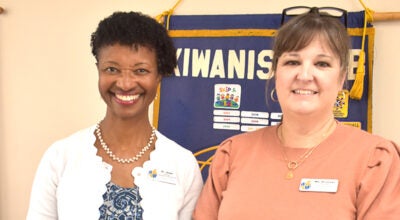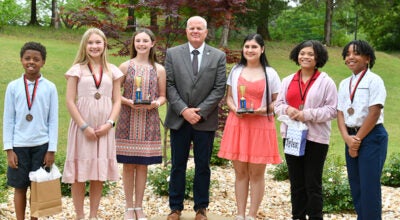Croom talks Roosevelt’s New Deal
Published 10:00 am Tuesday, October 26, 2021
|
Getting your Trinity Audio player ready...
|
WEST POINT — One of the earliest and most successful programs of President Franklin Roosevelt’s New Deal was the Civilian Conservation Corps (CCC). It was established in 1933 to relieve massive nationwide unemployment by providing conservation work for young, unmarried men. Projects included planting trees, building flood barriers, fighting forest fires and maintaining forest roads and trails.
The program went on until the U.S. involvement in World War II began in 1942. At its height, the CCC provided work opportunities and steady pay for up to 500,000 young men. They were paid $30 a month (which was pretty good in those days). They sent $25 of that back home to help their struggling families and could keep the remaining five dollars. Medical care along with meals and boarding was provided for them free of charge.
Recruits lived in work camps under semi-military leadership. During its decade-long period of service, the CCC kept up to three million young men busy at a time when jobs were extremely hard to find.
History teacher John E. Croom talked about west Georgia’s connection to the CCC at Sunday afternoon’s quarterly program of the Chattahoochee Valley Historical Society (CVHS), held in a second-floor classroom in Point University’s Lanier Academic Center.
Croom grew up in Columbus and graduated from Columbus High School in 1973. He went on to earn degrees from Columbus College and the University of Montevallo. He’s now a teacher in Oak Mountain. Croom has family connections to the CCC and grew up hearing many stories about the work the young men of the CCC did. He has a special interest in the work done on Pine Mountain from the young men stationed at work camps in Warm Springs and Chipley (now Pine Mountain).
He began his PowerPoint presentation by showing numerous photos taken in Georgia in the 1920s and 1930s. Some were scenes of downtown Atlanta and Columbus. One photo showed a young boy selling newspapers outside a country store with a large Coca-Cola sign in the background. One photo showed people having a picnic under large pine trees and others showed people working on farms. For the most part, the people appeared to be cheerful despite being emaciated and poorly clothed.
“Poverty during that time period was unrelenting,” Croom said.
Croom is in the process of writing a book about the CCC’s work in Harris and Meriwether counties. He has completed thorough research on the project. He has located some relevant information on the project from places as close by as the Chipley Historical Museum in Pine Mountain and as far away as a Swiss national library in Berne, Switzerland. He has copies of Georgia newspapers of the period and some newspapers produced by the CCC camps in Warm Springs and Chipley. One of them was published under the name “Happy Days,” embracing the FDR theme “Happy Days Are Here Again.”
President Roosevelt had a deep personal interest in building a park on Pine Mountain. He once said that if he could make things better in west-central Georgia, he could make them better nationwide.
He built strong friendships with two men from the local area, Cason Callaway and Henry Kimbrough. Both had unlimited access to him.
“A head of state might have a delay in getting through to him by phone, but those two men had unlimited access to him,” Croom said. “They could get through to him anytime.”
There was a brief period of prosperity after World War I, but the stock market crash of 1929 — some 92 years ago this week — sent the nation’s economy into a tailspin. The bad times weren’t as bad to many in the rural South. Since the Civil War, they’d known nothing but hard times anyway.
“At the dawn of the Great Depression, there existed 2.9 million people in Georgia,” Croom said. “Most of them were incredibly poor sharecroppers living on an annual income of around $200.”
Hard times did get worse when the price of cotton started falling.
Roosevelt had had a personal connection to west-central Georgia since the 1920s. After contracting polio, FDR was told about the healing waters of Warm Springs by George Foster Peabody of Columbus. He made a visit to Warm Springs, liked what he saw and purchased the Meriwether Inn and Spa along with a nearby farm and 100 acres at Dowdell’s Knob, the highest point of Pine Mountain.
“He fell in love with Georgia, and Georgia fell in love with him,” Croom said.
Georgians didn’t care too much for First Lady Eleanor Roosevelt. It was easy for them to believe a widely circulated story that she had told her northern friends that in Georgia “there wasn’t enough distance from the chicken pens to the dinner tables.”
The Roosevelt presidency is noted for its first 100 days. There was a big growth in government, designed to address a national crisis. There were a myriad of agencies created all known by letters of the alphabet. The Federal Emergency Relief Agency (FERA), for example, was the forerunner of today’s Federal Emergency Management Agency (FEMA). One of them, the Works Progress Administration (WPA) was stained by corruption.
“The CCC was the most successful organization created during this period,” Croom said. “It promised work, pay, a place to stay and care for their medical needs for up to 200,000 young men.”
Within five years, that number topped 500,000 at one point.
To be eligible, the young man had to be between 17 and 23 years of age, a U.S. citizen, unmarried, out of school and physically able to do strenuous work.
There were some companies for veterans who were older. Some of them in the CCC had served in the Boxer Rebellion in China in 1898 and in the Spanish-American War.
By the mid-1930s, there were 300,000 young men enrolled in the CCC, almost 8,000 of them in the state of Georgia. Isolationists didn’t like the military role in the camps. Some military men who gained widespread fame in World War II — men such as Douglas MacArthur and George C. Marshall — had administrative roles with the CCC in the 1930s.
Boys in the camps wore surplus uniforms left over from World War I. Camp leaders had military ranks.
“The CCC camps were set up like Army camps,” Croom said. “Most of them had somewhere between 50 and 80 buildings. An estimated 200 young men would be in each camp along with support personnel.”
Isolationists didn’t like the young men wearing Army uniforms with Army insignia. Eventually, this was changed to satisfy them.
The camp at Warm Springs was built on land donated by Dr. Neal Kitchens, who supported of FDR and the CCC.
“The camp was in the woods just outside Warm Springs,” Croom said. “I found the site by locating a baseball field that’s still there. It was one of the first camps but very crude compared to many others. Most of the young men slept in tents.”
A Georgia Tech graduate, Cecil Hays, was the camp supervisor. He was dedicated to the CCC and remained with the organization until it disbanded in 1942. In one year, the men from the Warm Springs camp planted 16,000 trees and put out 54 forest fires.
“They planted the trees following a knotted rope,” Croom said. “They would plant loblolly pine and shortleaf pines with the aid of that rope.”
Their workday ran from 8 a.m. to 4 p.m.
“They weren’t used to ending work that early in the day,” Croom said. “Most of them played sports such as baseball and basketball. Others took education classes in the evenings and some went to movies in nearby Manchester.”
There were two swimming pools in the area at the time. The young men enjoyed going to them during the warm weather season. Both pools closed following World War II.
By the mid-1930s, there was a goal of having a Pine Mountain Park. Men from both the Pine Mountain and the Chipley camps would be involved. The National Park Service purchased an estimated 1,000 acres along the summit of Pine Mountain and the work would start there.
Land was dirt cheap at the time. In most cases, worn-out farmland was going for 25 cents an acre. Cason Callaway was able to acquire 60,000 acres at one time. His land stretched almost from Chipley to Lake Harding.
FDR wanted to build a scenic drive along the summit of Pine Mountain. The road would start near Tip Top, where the Callaway Gardens Country Store is located today, and would eventually go all the way to Manchester, ending at State Route 85.
According to Croom, there’s a map of the proposed scenic drive at the Roosevelt Museum in Hyde Park, New York.
One of the scenic roads more memorable features is the stone bridge at King’s Gap, not far from the present state park office. The road, its overlooks and the road out to Dowdell’s Knob was built during this period. Cabins were built according to Department of Interior standards. As much native material as was feasible went into the construction. This included stone and skinned logs. Lake Delanore was constructed on the west side of the mountain in 1934. It’s around 15 acres in size and is still in use today.
There was a contest to name the lake. A woman from LaGrange won it. She suggested combining the D in FDR (Delano) with Eleanor from Mrs. Roosevelt.
The state park visitor center is a remarkable story in itself. It was designed by Cecil Hays and built during the dead of a cold winter.
“A group of about 50 young men did it during some bad weather,” Croom said. “It was an amazing feat.”
Outside the visitor center, one can see Pine Mountain Valley, where more CCC work was underway in the mid-1930s.
In 1935, work started on a colonial-style inn and lodge. It was finished the next spring and had a restaurant and a place where people could spend the night.
An estimated 300 people a day could be fed there.
Mr. Hays was something of a Renaissance man. He designed and supervised the construction of most everything that was being built. FDR admired the role he was taking and even called him by his first name, Cecil, on his many trips to see the work that was going on.
John C. Brooks was the landscape foreman on the CCC projects. He was later in charge of the landscaping during the development of Callaway Gardens in the early 1950s.
The Chipley camp was named in honor of Henry Kimbrough, the man who always seemed to get things done in the community.
One of these ideas was to build the Liberty Bell pool on the Chipley side of the mountain. One of its outstanding features are rocks in the shape of the 48 states on the bottom of the pool.
A woman named Mamie Harrison Carroll of the Mulberry Grove community headed up an effort to name Highway 27 for the president and to have a Pine Mountain Park.
The National Park Service continued to purchase land for the park. At 9,049 acres, it’s now the largest state park in Georgia.
When this beehive or work was going on along the Pine Mountain slopes, radio station WSB in Atlanta would go there to make live reports. The WPA made a color movie of the men at work on Pine Mountain. During this period, the boys from the CCC built some stone cabins near the summit of the mountain. They are still in use today.
The worst day during this period of constant building took place in February 1936.
“A dam failed,” Croom said. “Some 44 million gallons of water went through it. Fortunately, no one was killed, but they were determined to build it back.”
Eventually, they would build 15-acre Lake Franklin on the east side of the mountain. It’s in plain view from Dowdell’s Knob. Some 70 buildings went up around it. The site became a haven for Scout troops.
In 1938, “Asphalt Ed” Peavey paved the scenic road across the mountain. An estimated 1,000 people came to a barbecue to celebrate its opening and that first drive along a smoothly paved road. The new hard-surface road was a big key to the creation of Pine Mountain State Park that same year. In later years, an amphitheater would be built just outside the state park office. Dancing took place there on special occasions up until the 1970s.
In the late 1930s, the Warm Springs camp disbanded, with the CCC boys being transferred to South Carolina. Camp Kimbrough remained open until late 1941 when it had become obvious the U.S. would be pulled into the Second World War.
One of the biggest fans of the work done on Pine Mountain was President Roosevelt. He continued to make frequent visits to Dowdell’s Knob on his trips to Georgia. He made his last visit on April 10, 1945. He died two days later in the Little White House. As a tribute to this great friend for Georgia and the U.S., the state park’s name was changed to the Franklin D. Roosevelt State Park just five days later, on April 17, 1945.
“Nationally, the CCC was at its peak in 1935,” Croom said. “There were 500,000 enrollees and 2,000 camps across the U.S. The men from the CCC planted over 3.8 billion trees and built countless fire break roads. It’s been estimated that between one-half and two-thirds of them served our country during World War II.”
Croom described Franklin D. Roosevelt State Park as a lasting treasure of the president’s legacy in Georgia and the New Deal.
“It’s a legacy that lasts till this day,” he said.




